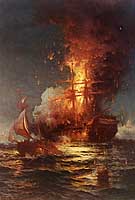
The capture of USS Philadelphia by the Tripolitans at the end of October 1803 seriously reduced the U.S. Navy's Mediterranean force and potentially increased the enemy's seagoing offensive power. Though it turned out that Tripoli lacked the resources needed to operate the captured frigate, this was by no means clear at the time, and Commodore Edward Preble began planning to eliminate the problem. The idea of recapturing the Philadelphia in Tripoli's well-fortified harbor offered little chance of success, but her destruction appeared feasible, if heavy losses by the raiding party were accepted.
There was no shortage of volunteers for this hazardous mission. Lieutenant Stephen Decatur, Commanding Officer of the schooner Enterprise, was appointed to lead the operation, which would be conducted using a recently captured local ketch that was appropriately renamed Intrepid. With a crew taken from Enterprise and the flagship Constitution, plus a Sicilian pilot who was familiar with Tripoli harbor, Decatur sailed from Syracuse on 3 February 1804. Storms kept Intrepid at sea for nearly two weeks, with her people enduring much from crowded circumstances, poor food and the generally filthy condition of their vessel.
On 16 February Decatur approached Tripoli, keeping all but a few of his men below decks to maintain Intrepid's appearance as a local trading vessel. That night, navigating by moonlight, he sailed into the harbor and, claiming to have lost his anchors, requested permission to tie up alongside the Philadelphia. This was granted, but the disguise was discovered as the two came close and an alarm cry rang out. Decatur immediately ordered his men to board, which they did so swiftly that the frigate's guards had no time to organize resistance. Most jumped overboard and swam ashore, while the Americans rapidly prepared to burn their prize. Less than twenty minutes later the Philadelphia was blazing brightly. Casting off just ahead of the flames, the Intrepid's men rowed out of the now well-lighted harbor, pursued by gunfire. The operation was a complete success: Philadelphia burned to the waterline and sank, while none of the raiders were killed and only one injured. In the words of British Admiral Horatio Nelson, this was "the most bold and daring act of the age".
This page features all the views we have related to the burning of the Frigate Philadelphia in Tripoli harbor, 16 February 1804.
For views related to the stranding and capture of this ship,
see:
| If you want higher resolution reproductions than the Online Library's digital images, see: How to Obtain Photographic Reproductions. |
Click on the small photograph to prompt a larger view of the same image.
|
Photo #: NH 56745 Burning of the frigate Philadelphia in Tripoli harbor, 16 February 1804 Chart by Charles Wellington Furlong, 1904, depicting (by dot and dash lines) the course followed by the ketch Intrepid, under Lieutenant Stephen Decatur, as she entered and left Tripoli harbor on her mission to destroy the captured USS Philadelphia. Heavy dashed line indicates Philadelphia's drift after she was set afire. Position "A" marks Philadelphia's position when boarded by Decatur's men, while "B" is the location of her wreck when Furlong located it about a century later and recovered artifacts. Position "X" (just west of the Jerba Passage) is the location of Intrepid's wreck after she blew up on 4 September 1804, during another mission into Tripoli harbor. Courtesy of Charles Wellington Furlong, July 1939. U.S. Naval Historical Center Photograph. Online Image: 115KB; 690 x 650 pixels |
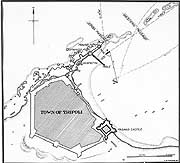 |
|
Photo #: NH 1340 "Boarding the Philadelphia" Halftone reproduction of an artwork by J.O. Davidson, depicting the boarding of the captured U.S. Frigate Philadelphia by a party led by Lieutenant Stephen Decatur, in Tripoli harbor, 16 February 1804. Copied from a book entitled "History of the Navy". U.S. Naval Historical Center Photograph. Online Image: 141KB; 520 x 740 pixels |
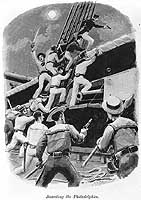 |
|
Photo #: NH 50528 Burning of USS Philadelphia, 16 February 1804 Reproduction of a 19th Century engraving, depicting Lieutenant Stephen Decatur leading his men as they recaptured the Philadelphia in Tripoli harbor, prior to setting her afire. Published in the "American Weekly" supplement to the "Washington Times-Herald", circa March-April 1940, illustrating an article by Harold T. Wilkins. U.S. Naval Historical Center Photograph. Online Image: 152KB; 440 x 765 pixels |
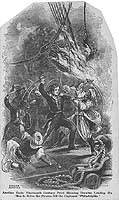 |
|
Photo #: KN-10849 (Color) "Burning of the Frigate Philadelphia in the Harbor of Tripoli, February 16, 1804" Oil on canvas, 60" by 42", by Edward Moran (1829-1901), signed and dated by the artist, 1897. It depicts USS Philadelphia, previously captured by the Tripolitans, ablaze after she was boarded and set afire by a party from the ketch Intrepid led by Lieutenant Stephen Decatur. Painting in the U.S. Naval Academy Museum Collection. Gift of Paul E. Sutro, 1940. Official U.S. Navy Photograph. Online Image: 84KB; 500 x 765 pixels Reproductions of this image may also be available through the National Archives photographic reproduction system as Photo # 428-KN-10849 |
 |
|
Photo #: NH 50459 Burning of USS Philadelphia, 16 February 1804 19th Century painting depicting the Philadelphia aflame in Tripoli harbor, after she had been captured and set afire by Lieutenant Stephen Decatur's boarding party. Courtesy of President Franklin D. Roosevelt, 1936. U.S. Naval Historical Center Photograph. Online Image: 127KB; 740 x 570 pixels |
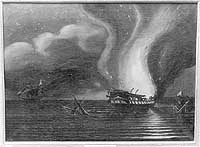 |
|
Photo #: NH 56735 Destruction of USS Philadelphia in Tripoli harbor, 16 February 1804 Artwork from the collection of Mr. Stephen Decatur, depicting Philadelphia afire after she was boarded and set ablaze by a party led by Lieutenant Stephen Decatur. In the left foreground is the ketch Intrepid, which Decatur used during this mission. U.S. Naval Historical Center Photograph. Online Image: 119KB; 740 x 610 pixels |
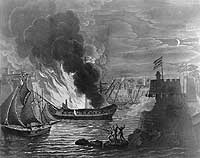 |
|
Photo #: NH 56751 "Burning of the Frigate Philadelphia in the Harbour of Tripoli, 16th Feb. 1804, by 70 Gallant Tars of Columbia commanded by Lieut. Decatur" Aquatint engraving by F. Kearney, published in August 1808. It depicts the ketch Intrepid, under Lieutenant Stephen Decatur, at left, leaving Tripoli harbor after her crew had boarded the Philadelphia and set the ship ablaze. U.S. Naval Historical Center Photograph. Online Image: 141KB; 740 x 590 pixels |
 |
|
Photo #: NH 60689 "Burning of the Philadelphia" 19th Century engraving, depicting the burning of USS USS Philadelphia in Tripoli harbor by a boarding party led by Lieutenant Stephen Decatur, 16 February 1804. U.S. Naval Historical Center Photograph. Online Image: 144KB; 740 x 470 pixels |
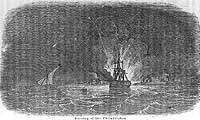 |
The following image may represent an incident of the boarding and destruction of USS Philadelphia, but is visually much more like other views of the capture of a Tripolitan gunboat on 3 August 1804:
For views related to the stranding and capture of this ship,
see:
| If you want higher resolution reproductions than the Online Library's digital images, see: How to Obtain Photographic Reproductions. |
Page made 17 November 2002
Text added 23 July 2003